BTEC Unit 8: Innovation and Commercialisation Report - Heinz
VerifiedAdded on 2023/01/10
|14
|4630
|88
Report
AI Summary
This report provides a comprehensive analysis of Heinz's innovation and commercialization strategies within the food processing industry. It begins by defining innovation and commercialization and emphasizing their importance to Heinz. The report then delves into the roles of invention and innovation, highlighting the influence of internal and external factors like technology and globalization. It explores how organizational leadership, teamwork, culture, and vision shape Heinz's innovation and commercialization functions. The report further examines the 4 P's of innovation (Product, Position, Process, Paradigm) and the innovation funnel as strategic frameworks. Finally, it discusses developments in frugal innovation, illustrating its application with examples. Overall, the report offers insights into how Heinz maintains its competitive edge through strategic innovation and commercialization practices.
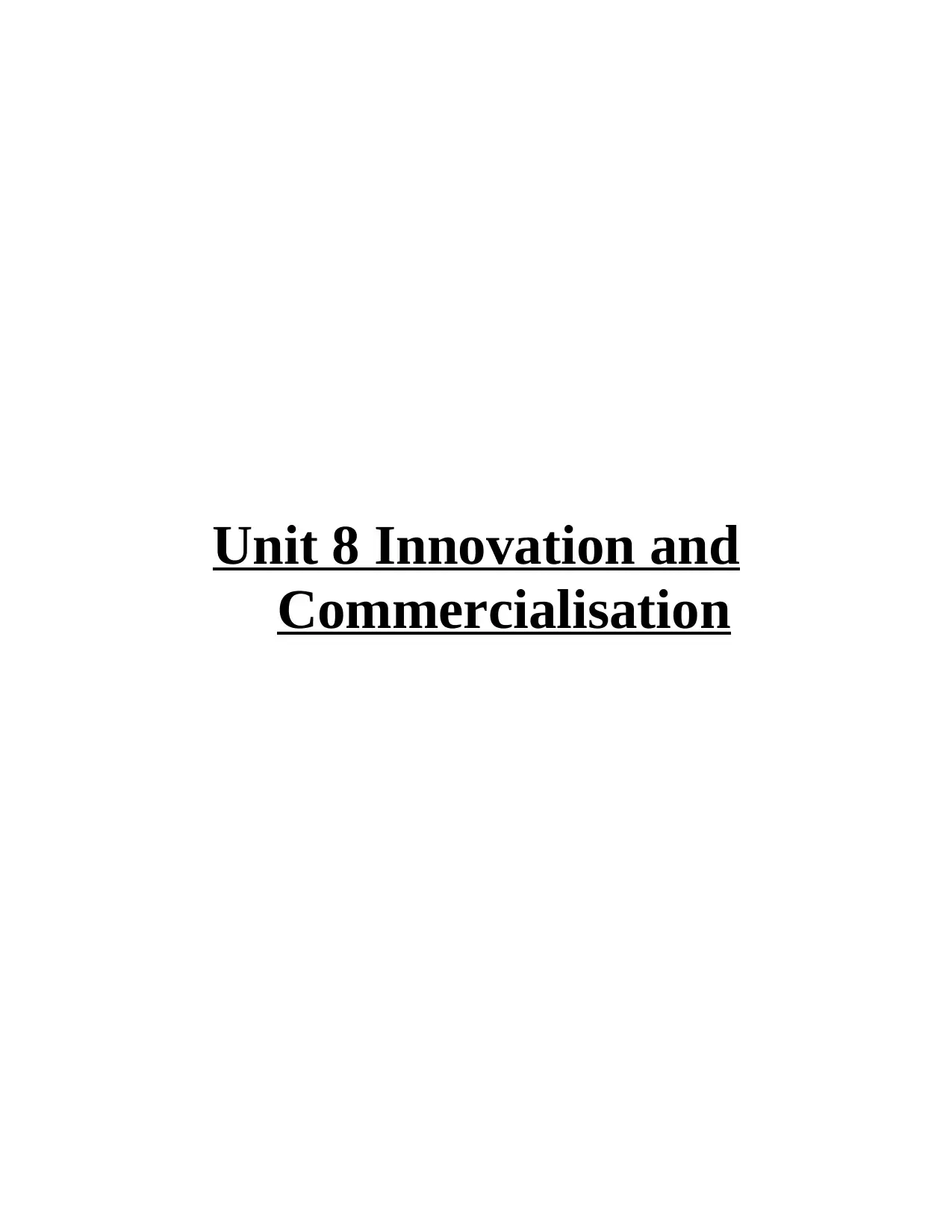
Unit 8 Innovation and
Commercialisation
Commercialisation
Paraphrase This Document
Need a fresh take? Get an instant paraphrase of this document with our AI Paraphraser
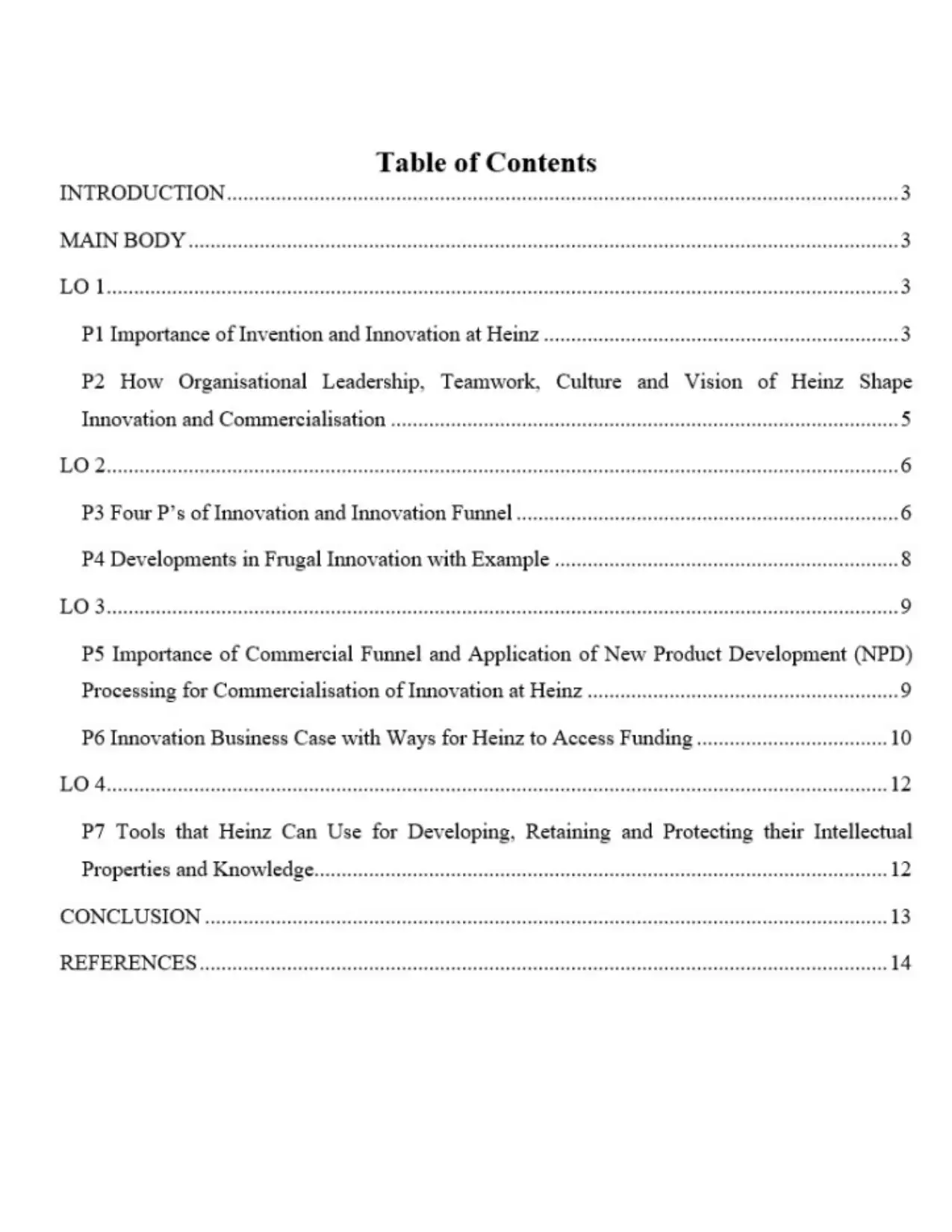

INTRODUCTION
Innovation is the strategic process through which a business organisation adds additional
value to its existing goods and services in an effort to better satisfy the demands, needs,
preferences and requirements of their customers. Commercialisation is the process through
which a business organisation introduces new goods and products into the consumer markets
(Gross and et.al., 2018). This report analyses the innovation and commercialisation operations of
Heinz, which is a food processing business organisation operating within the food processing
industries. Heinz was founded in 1869, 151 years ago and currently operates from its
headquarters in Pennsylvania, USA. On account of its sustained and long operations, Heinz has
expanded their business operations to global markets, with Heinz currently manufacturing
thousands of diverse food products through their manufacturing plants, which are located in 6
different continents of the world. This allows for Heinz to service various different global
markets, with Heinz currently serving customers in more than 200 different countries around the
world. In the USA, Heinz has been ranked as the first business organisation in Ketchup products,
on account of it capturing over 50% of the available market share.
MAIN BODY
LO 1
P1 Importance of Invention and Innovation at Heinz
Innovation is the strategic process through which a business organisation such as Heinz
can place emphasis on adding addition value to its manufactured and invented goods and
products which are already present within the external markets with the intention to better satisfy
the demands, requirements, needs and preferences of their customers within the food processing
industry. Addition of value to existing goods and products of Heinz can also allow for the
business organisation to be able to effectively meet the changing and diverse needs and demands
of the consumers within the food processing markets. Through innovation process, Heinz can
apply new and unique solutions to their existing market goods and products and increase their
Innovation is the strategic process through which a business organisation adds additional
value to its existing goods and services in an effort to better satisfy the demands, needs,
preferences and requirements of their customers. Commercialisation is the process through
which a business organisation introduces new goods and products into the consumer markets
(Gross and et.al., 2018). This report analyses the innovation and commercialisation operations of
Heinz, which is a food processing business organisation operating within the food processing
industries. Heinz was founded in 1869, 151 years ago and currently operates from its
headquarters in Pennsylvania, USA. On account of its sustained and long operations, Heinz has
expanded their business operations to global markets, with Heinz currently manufacturing
thousands of diverse food products through their manufacturing plants, which are located in 6
different continents of the world. This allows for Heinz to service various different global
markets, with Heinz currently serving customers in more than 200 different countries around the
world. In the USA, Heinz has been ranked as the first business organisation in Ketchup products,
on account of it capturing over 50% of the available market share.
MAIN BODY
LO 1
P1 Importance of Invention and Innovation at Heinz
Innovation is the strategic process through which a business organisation such as Heinz
can place emphasis on adding addition value to its manufactured and invented goods and
products which are already present within the external markets with the intention to better satisfy
the demands, requirements, needs and preferences of their customers within the food processing
industry. Addition of value to existing goods and products of Heinz can also allow for the
business organisation to be able to effectively meet the changing and diverse needs and demands
of the consumers within the food processing markets. Through innovation process, Heinz can
apply new and unique solutions to their existing market goods and products and increase their
⊘ This is a preview!⊘
Do you want full access?
Subscribe today to unlock all pages.

Trusted by 1+ million students worldwide
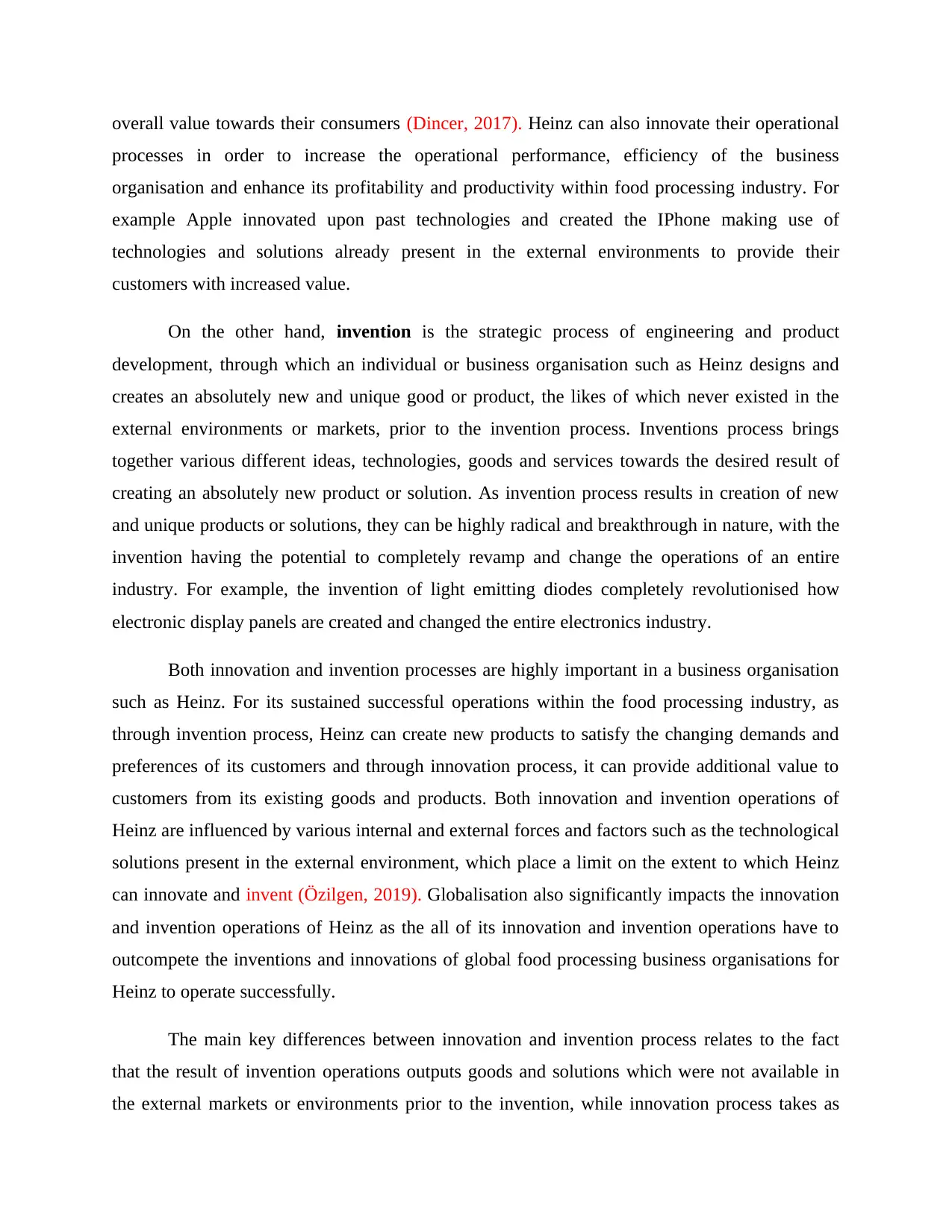
overall value towards their consumers (Dincer, 2017). Heinz can also innovate their operational
processes in order to increase the operational performance, efficiency of the business
organisation and enhance its profitability and productivity within food processing industry. For
example Apple innovated upon past technologies and created the IPhone making use of
technologies and solutions already present in the external environments to provide their
customers with increased value.
On the other hand, invention is the strategic process of engineering and product
development, through which an individual or business organisation such as Heinz designs and
creates an absolutely new and unique good or product, the likes of which never existed in the
external environments or markets, prior to the invention process. Inventions process brings
together various different ideas, technologies, goods and services towards the desired result of
creating an absolutely new product or solution. As invention process results in creation of new
and unique products or solutions, they can be highly radical and breakthrough in nature, with the
invention having the potential to completely revamp and change the operations of an entire
industry. For example, the invention of light emitting diodes completely revolutionised how
electronic display panels are created and changed the entire electronics industry.
Both innovation and invention processes are highly important in a business organisation
such as Heinz. For its sustained successful operations within the food processing industry, as
through invention process, Heinz can create new products to satisfy the changing demands and
preferences of its customers and through innovation process, it can provide additional value to
customers from its existing goods and products. Both innovation and invention operations of
Heinz are influenced by various internal and external forces and factors such as the technological
solutions present in the external environment, which place a limit on the extent to which Heinz
can innovate and invent (Özilgen, 2019). Globalisation also significantly impacts the innovation
and invention operations of Heinz as the all of its innovation and invention operations have to
outcompete the inventions and innovations of global food processing business organisations for
Heinz to operate successfully.
The main key differences between innovation and invention process relates to the fact
that the result of invention operations outputs goods and solutions which were not available in
the external markets or environments prior to the invention, while innovation process takes as
processes in order to increase the operational performance, efficiency of the business
organisation and enhance its profitability and productivity within food processing industry. For
example Apple innovated upon past technologies and created the IPhone making use of
technologies and solutions already present in the external environments to provide their
customers with increased value.
On the other hand, invention is the strategic process of engineering and product
development, through which an individual or business organisation such as Heinz designs and
creates an absolutely new and unique good or product, the likes of which never existed in the
external environments or markets, prior to the invention process. Inventions process brings
together various different ideas, technologies, goods and services towards the desired result of
creating an absolutely new product or solution. As invention process results in creation of new
and unique products or solutions, they can be highly radical and breakthrough in nature, with the
invention having the potential to completely revamp and change the operations of an entire
industry. For example, the invention of light emitting diodes completely revolutionised how
electronic display panels are created and changed the entire electronics industry.
Both innovation and invention processes are highly important in a business organisation
such as Heinz. For its sustained successful operations within the food processing industry, as
through invention process, Heinz can create new products to satisfy the changing demands and
preferences of its customers and through innovation process, it can provide additional value to
customers from its existing goods and products. Both innovation and invention operations of
Heinz are influenced by various internal and external forces and factors such as the technological
solutions present in the external environment, which place a limit on the extent to which Heinz
can innovate and invent (Özilgen, 2019). Globalisation also significantly impacts the innovation
and invention operations of Heinz as the all of its innovation and invention operations have to
outcompete the inventions and innovations of global food processing business organisations for
Heinz to operate successfully.
The main key differences between innovation and invention process relates to the fact
that the result of invention operations outputs goods and solutions which were not available in
the external markets or environments prior to the invention, while innovation process takes as
Paraphrase This Document
Need a fresh take? Get an instant paraphrase of this document with our AI Paraphraser
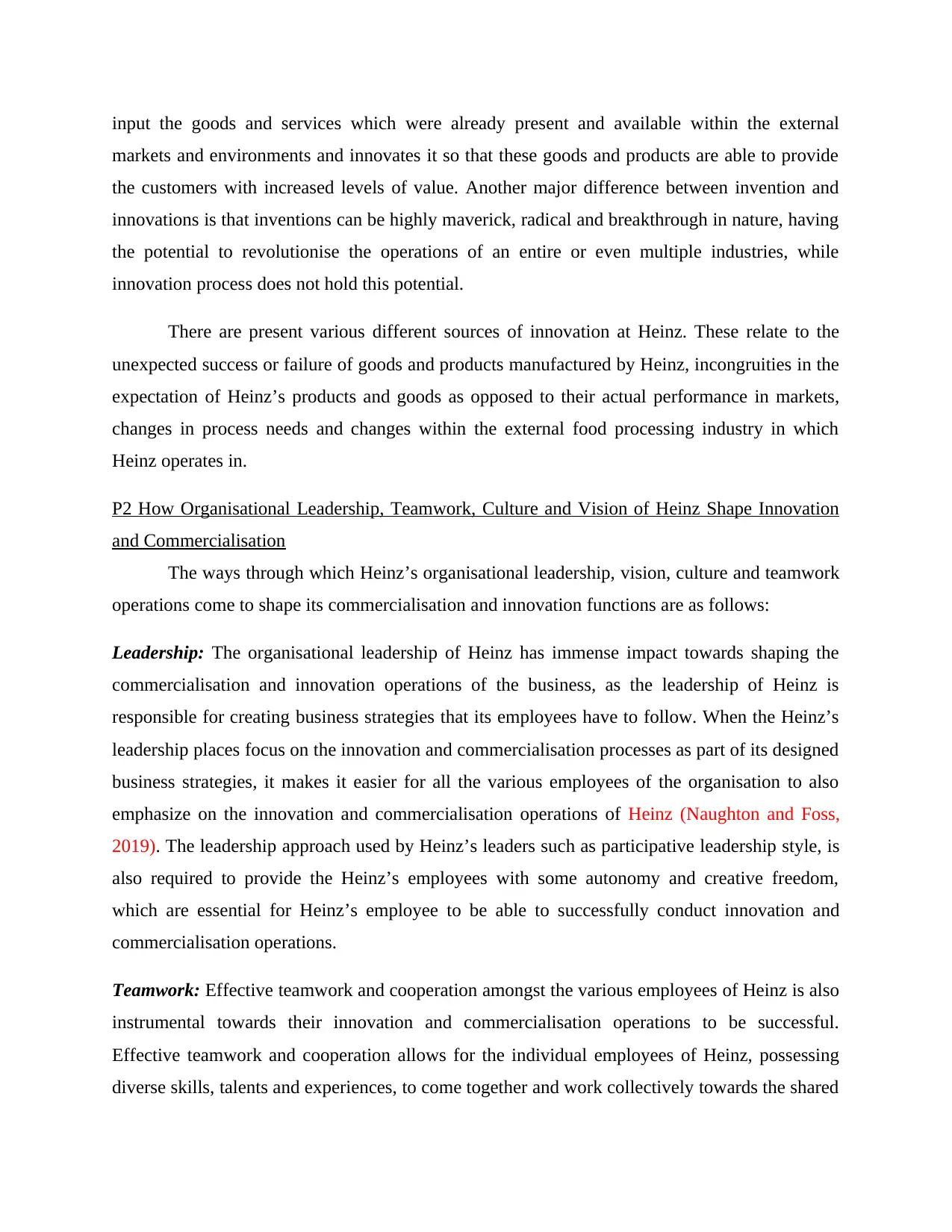
input the goods and services which were already present and available within the external
markets and environments and innovates it so that these goods and products are able to provide
the customers with increased levels of value. Another major difference between invention and
innovations is that inventions can be highly maverick, radical and breakthrough in nature, having
the potential to revolutionise the operations of an entire or even multiple industries, while
innovation process does not hold this potential.
There are present various different sources of innovation at Heinz. These relate to the
unexpected success or failure of goods and products manufactured by Heinz, incongruities in the
expectation of Heinz’s products and goods as opposed to their actual performance in markets,
changes in process needs and changes within the external food processing industry in which
Heinz operates in.
P2 How Organisational Leadership, Teamwork, Culture and Vision of Heinz Shape Innovation
and Commercialisation
The ways through which Heinz’s organisational leadership, vision, culture and teamwork
operations come to shape its commercialisation and innovation functions are as follows:
Leadership: The organisational leadership of Heinz has immense impact towards shaping the
commercialisation and innovation operations of the business, as the leadership of Heinz is
responsible for creating business strategies that its employees have to follow. When the Heinz’s
leadership places focus on the innovation and commercialisation processes as part of its designed
business strategies, it makes it easier for all the various employees of the organisation to also
emphasize on the innovation and commercialisation operations of Heinz (Naughton and Foss,
2019). The leadership approach used by Heinz’s leaders such as participative leadership style, is
also required to provide the Heinz’s employees with some autonomy and creative freedom,
which are essential for Heinz’s employee to be able to successfully conduct innovation and
commercialisation operations.
Teamwork: Effective teamwork and cooperation amongst the various employees of Heinz is also
instrumental towards their innovation and commercialisation operations to be successful.
Effective teamwork and cooperation allows for the individual employees of Heinz, possessing
diverse skills, talents and experiences, to come together and work collectively towards the shared
markets and environments and innovates it so that these goods and products are able to provide
the customers with increased levels of value. Another major difference between invention and
innovations is that inventions can be highly maverick, radical and breakthrough in nature, having
the potential to revolutionise the operations of an entire or even multiple industries, while
innovation process does not hold this potential.
There are present various different sources of innovation at Heinz. These relate to the
unexpected success or failure of goods and products manufactured by Heinz, incongruities in the
expectation of Heinz’s products and goods as opposed to their actual performance in markets,
changes in process needs and changes within the external food processing industry in which
Heinz operates in.
P2 How Organisational Leadership, Teamwork, Culture and Vision of Heinz Shape Innovation
and Commercialisation
The ways through which Heinz’s organisational leadership, vision, culture and teamwork
operations come to shape its commercialisation and innovation functions are as follows:
Leadership: The organisational leadership of Heinz has immense impact towards shaping the
commercialisation and innovation operations of the business, as the leadership of Heinz is
responsible for creating business strategies that its employees have to follow. When the Heinz’s
leadership places focus on the innovation and commercialisation processes as part of its designed
business strategies, it makes it easier for all the various employees of the organisation to also
emphasize on the innovation and commercialisation operations of Heinz (Naughton and Foss,
2019). The leadership approach used by Heinz’s leaders such as participative leadership style, is
also required to provide the Heinz’s employees with some autonomy and creative freedom,
which are essential for Heinz’s employee to be able to successfully conduct innovation and
commercialisation operations.
Teamwork: Effective teamwork and cooperation amongst the various employees of Heinz is also
instrumental towards their innovation and commercialisation operations to be successful.
Effective teamwork and cooperation allows for the individual employees of Heinz, possessing
diverse skills, talents and experiences, to come together and work collectively towards the shared
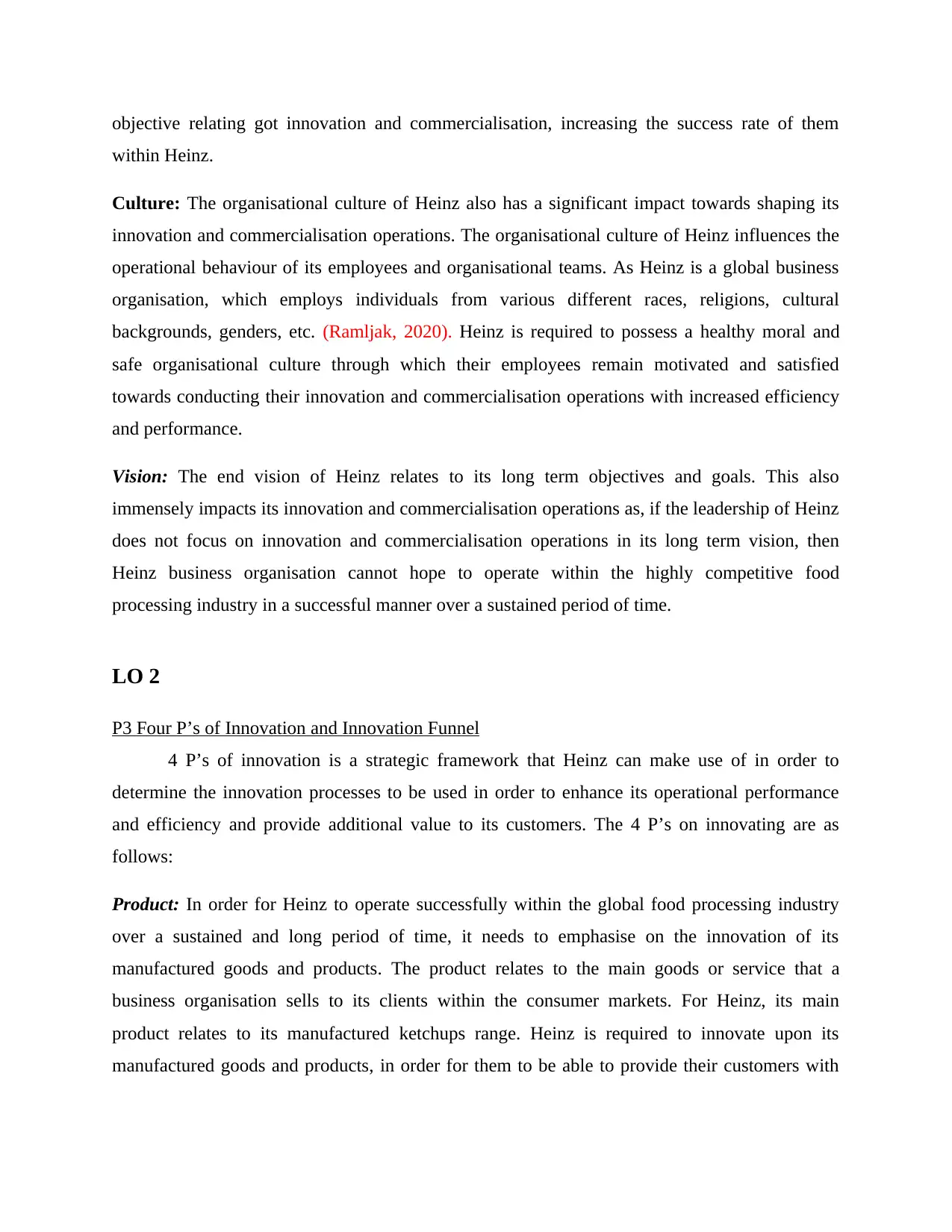
objective relating got innovation and commercialisation, increasing the success rate of them
within Heinz.
Culture: The organisational culture of Heinz also has a significant impact towards shaping its
innovation and commercialisation operations. The organisational culture of Heinz influences the
operational behaviour of its employees and organisational teams. As Heinz is a global business
organisation, which employs individuals from various different races, religions, cultural
backgrounds, genders, etc. (Ramljak, 2020). Heinz is required to possess a healthy moral and
safe organisational culture through which their employees remain motivated and satisfied
towards conducting their innovation and commercialisation operations with increased efficiency
and performance.
Vision: The end vision of Heinz relates to its long term objectives and goals. This also
immensely impacts its innovation and commercialisation operations as, if the leadership of Heinz
does not focus on innovation and commercialisation operations in its long term vision, then
Heinz business organisation cannot hope to operate within the highly competitive food
processing industry in a successful manner over a sustained period of time.
LO 2
P3 Four P’s of Innovation and Innovation Funnel
4 P’s of innovation is a strategic framework that Heinz can make use of in order to
determine the innovation processes to be used in order to enhance its operational performance
and efficiency and provide additional value to its customers. The 4 P’s on innovating are as
follows:
Product: In order for Heinz to operate successfully within the global food processing industry
over a sustained and long period of time, it needs to emphasise on the innovation of its
manufactured goods and products. The product relates to the main goods or service that a
business organisation sells to its clients within the consumer markets. For Heinz, its main
product relates to its manufactured ketchups range. Heinz is required to innovate upon its
manufactured goods and products, in order for them to be able to provide their customers with
within Heinz.
Culture: The organisational culture of Heinz also has a significant impact towards shaping its
innovation and commercialisation operations. The organisational culture of Heinz influences the
operational behaviour of its employees and organisational teams. As Heinz is a global business
organisation, which employs individuals from various different races, religions, cultural
backgrounds, genders, etc. (Ramljak, 2020). Heinz is required to possess a healthy moral and
safe organisational culture through which their employees remain motivated and satisfied
towards conducting their innovation and commercialisation operations with increased efficiency
and performance.
Vision: The end vision of Heinz relates to its long term objectives and goals. This also
immensely impacts its innovation and commercialisation operations as, if the leadership of Heinz
does not focus on innovation and commercialisation operations in its long term vision, then
Heinz business organisation cannot hope to operate within the highly competitive food
processing industry in a successful manner over a sustained period of time.
LO 2
P3 Four P’s of Innovation and Innovation Funnel
4 P’s of innovation is a strategic framework that Heinz can make use of in order to
determine the innovation processes to be used in order to enhance its operational performance
and efficiency and provide additional value to its customers. The 4 P’s on innovating are as
follows:
Product: In order for Heinz to operate successfully within the global food processing industry
over a sustained and long period of time, it needs to emphasise on the innovation of its
manufactured goods and products. The product relates to the main goods or service that a
business organisation sells to its clients within the consumer markets. For Heinz, its main
product relates to its manufactured ketchups range. Heinz is required to innovate upon its
manufactured goods and products, in order for them to be able to provide their customers with
⊘ This is a preview!⊘
Do you want full access?
Subscribe today to unlock all pages.

Trusted by 1+ million students worldwide

enhanced value in order to effectively satisfy their long term demands, needs, preferences and
requirements.
Position: Position relates to the changes that Heinz can make with respect to their manufactured
goods and products being introduced into the consumer markets. Heinz is required to effectively
position themselves in order for their introduced manufactured goods and products to be able to
effectively satisfy the need, demands and preferences of their targeted customers (Adelowo,
Akinwale and Olaopa, 2017). Doing this can open up new market segments to Heinz in order for
them to capture these segments and grow, expand their business operations and increase their
operational and financial performance. Heinz needs to target customers belonging to all
economic classes with their target customer being from all races, religions, genders, cultural
backgrounds, nationalities, demographics etc.
Process: This relates to the operational processes that Heinz uses to manufacture, store and
distribute their goods and services to the customers in the external markets. Heinz is required to
place emphasis on the innovation of its operational manufacturing, storing and distribution
processes in order to increase its operational efficiency, performance, productivity and
profitability within the global food processing industry, which can allow for the business
organisation to grow and expand its business operations to further heights.
Paradigm: This refers to the innovation regarding how, where and why the customers of the
food processing industry make use of the goods and products that are manufactured by Heinz.
This comprises of the values, beliefs, theories and doctrines of Heinz. Paradigm innovations
within Heinz can be immensely radical in nature either contributing towards immense success of
the business organisation or the failure of Heinz in food processing industry of the world.
Paradigm includes innovation of Heinz’s organisational vision, goals, objectives, business
strategies etc.
Innovation Funnel:
In combination of the 4 P’s of innovation framework, Heinz can also make use of the
innovation funnel mechanism to effectively influence and shape tis innovation and
commercialisation operations to be conducted successfully. Innovation funnel is a strategic
framework that includes dedicated mechanisms which the employees of Heinz can make use of
requirements.
Position: Position relates to the changes that Heinz can make with respect to their manufactured
goods and products being introduced into the consumer markets. Heinz is required to effectively
position themselves in order for their introduced manufactured goods and products to be able to
effectively satisfy the need, demands and preferences of their targeted customers (Adelowo,
Akinwale and Olaopa, 2017). Doing this can open up new market segments to Heinz in order for
them to capture these segments and grow, expand their business operations and increase their
operational and financial performance. Heinz needs to target customers belonging to all
economic classes with their target customer being from all races, religions, genders, cultural
backgrounds, nationalities, demographics etc.
Process: This relates to the operational processes that Heinz uses to manufacture, store and
distribute their goods and services to the customers in the external markets. Heinz is required to
place emphasis on the innovation of its operational manufacturing, storing and distribution
processes in order to increase its operational efficiency, performance, productivity and
profitability within the global food processing industry, which can allow for the business
organisation to grow and expand its business operations to further heights.
Paradigm: This refers to the innovation regarding how, where and why the customers of the
food processing industry make use of the goods and products that are manufactured by Heinz.
This comprises of the values, beliefs, theories and doctrines of Heinz. Paradigm innovations
within Heinz can be immensely radical in nature either contributing towards immense success of
the business organisation or the failure of Heinz in food processing industry of the world.
Paradigm includes innovation of Heinz’s organisational vision, goals, objectives, business
strategies etc.
Innovation Funnel:
In combination of the 4 P’s of innovation framework, Heinz can also make use of the
innovation funnel mechanism to effectively influence and shape tis innovation and
commercialisation operations to be conducted successfully. Innovation funnel is a strategic
framework that includes dedicated mechanisms which the employees of Heinz can make use of
Paraphrase This Document
Need a fresh take? Get an instant paraphrase of this document with our AI Paraphraser
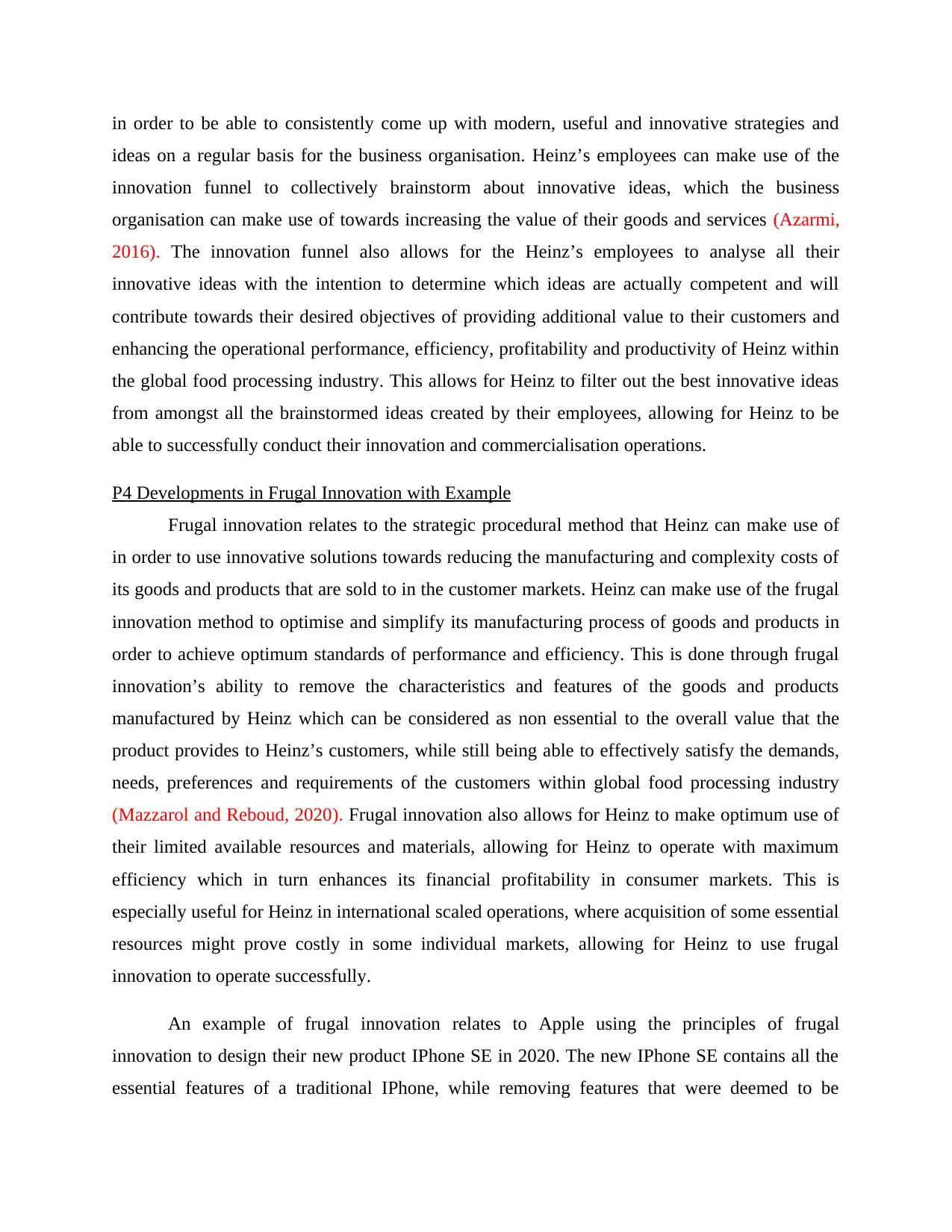
in order to be able to consistently come up with modern, useful and innovative strategies and
ideas on a regular basis for the business organisation. Heinz’s employees can make use of the
innovation funnel to collectively brainstorm about innovative ideas, which the business
organisation can make use of towards increasing the value of their goods and services (Azarmi,
2016). The innovation funnel also allows for the Heinz’s employees to analyse all their
innovative ideas with the intention to determine which ideas are actually competent and will
contribute towards their desired objectives of providing additional value to their customers and
enhancing the operational performance, efficiency, profitability and productivity of Heinz within
the global food processing industry. This allows for Heinz to filter out the best innovative ideas
from amongst all the brainstormed ideas created by their employees, allowing for Heinz to be
able to successfully conduct their innovation and commercialisation operations.
P4 Developments in Frugal Innovation with Example
Frugal innovation relates to the strategic procedural method that Heinz can make use of
in order to use innovative solutions towards reducing the manufacturing and complexity costs of
its goods and products that are sold to in the customer markets. Heinz can make use of the frugal
innovation method to optimise and simplify its manufacturing process of goods and products in
order to achieve optimum standards of performance and efficiency. This is done through frugal
innovation’s ability to remove the characteristics and features of the goods and products
manufactured by Heinz which can be considered as non essential to the overall value that the
product provides to Heinz’s customers, while still being able to effectively satisfy the demands,
needs, preferences and requirements of the customers within global food processing industry
(Mazzarol and Reboud, 2020). Frugal innovation also allows for Heinz to make optimum use of
their limited available resources and materials, allowing for Heinz to operate with maximum
efficiency which in turn enhances its financial profitability in consumer markets. This is
especially useful for Heinz in international scaled operations, where acquisition of some essential
resources might prove costly in some individual markets, allowing for Heinz to use frugal
innovation to operate successfully.
An example of frugal innovation relates to Apple using the principles of frugal
innovation to design their new product IPhone SE in 2020. The new IPhone SE contains all the
essential features of a traditional IPhone, while removing features that were deemed to be
ideas on a regular basis for the business organisation. Heinz’s employees can make use of the
innovation funnel to collectively brainstorm about innovative ideas, which the business
organisation can make use of towards increasing the value of their goods and services (Azarmi,
2016). The innovation funnel also allows for the Heinz’s employees to analyse all their
innovative ideas with the intention to determine which ideas are actually competent and will
contribute towards their desired objectives of providing additional value to their customers and
enhancing the operational performance, efficiency, profitability and productivity of Heinz within
the global food processing industry. This allows for Heinz to filter out the best innovative ideas
from amongst all the brainstormed ideas created by their employees, allowing for Heinz to be
able to successfully conduct their innovation and commercialisation operations.
P4 Developments in Frugal Innovation with Example
Frugal innovation relates to the strategic procedural method that Heinz can make use of
in order to use innovative solutions towards reducing the manufacturing and complexity costs of
its goods and products that are sold to in the customer markets. Heinz can make use of the frugal
innovation method to optimise and simplify its manufacturing process of goods and products in
order to achieve optimum standards of performance and efficiency. This is done through frugal
innovation’s ability to remove the characteristics and features of the goods and products
manufactured by Heinz which can be considered as non essential to the overall value that the
product provides to Heinz’s customers, while still being able to effectively satisfy the demands,
needs, preferences and requirements of the customers within global food processing industry
(Mazzarol and Reboud, 2020). Frugal innovation also allows for Heinz to make optimum use of
their limited available resources and materials, allowing for Heinz to operate with maximum
efficiency which in turn enhances its financial profitability in consumer markets. This is
especially useful for Heinz in international scaled operations, where acquisition of some essential
resources might prove costly in some individual markets, allowing for Heinz to use frugal
innovation to operate successfully.
An example of frugal innovation relates to Apple using the principles of frugal
innovation to design their new product IPhone SE in 2020. The new IPhone SE contains all the
essential features of a traditional IPhone, while removing features that were deemed to be
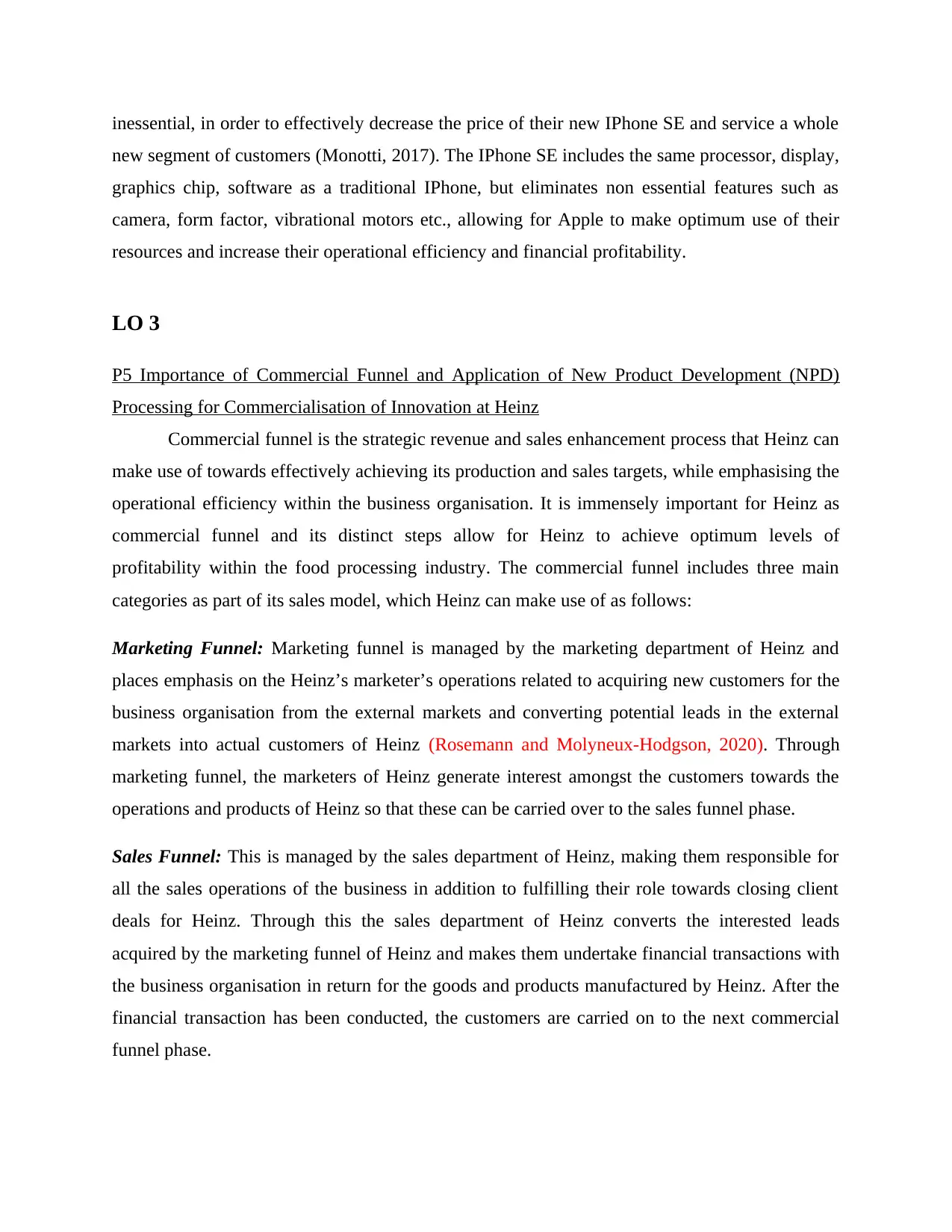
inessential, in order to effectively decrease the price of their new IPhone SE and service a whole
new segment of customers (Monotti, 2017). The IPhone SE includes the same processor, display,
graphics chip, software as a traditional IPhone, but eliminates non essential features such as
camera, form factor, vibrational motors etc., allowing for Apple to make optimum use of their
resources and increase their operational efficiency and financial profitability.
LO 3
P5 Importance of Commercial Funnel and Application of New Product Development (NPD)
Processing for Commercialisation of Innovation at Heinz
Commercial funnel is the strategic revenue and sales enhancement process that Heinz can
make use of towards effectively achieving its production and sales targets, while emphasising the
operational efficiency within the business organisation. It is immensely important for Heinz as
commercial funnel and its distinct steps allow for Heinz to achieve optimum levels of
profitability within the food processing industry. The commercial funnel includes three main
categories as part of its sales model, which Heinz can make use of as follows:
Marketing Funnel: Marketing funnel is managed by the marketing department of Heinz and
places emphasis on the Heinz’s marketer’s operations related to acquiring new customers for the
business organisation from the external markets and converting potential leads in the external
markets into actual customers of Heinz (Rosemann and Molyneux-Hodgson, 2020). Through
marketing funnel, the marketers of Heinz generate interest amongst the customers towards the
operations and products of Heinz so that these can be carried over to the sales funnel phase.
Sales Funnel: This is managed by the sales department of Heinz, making them responsible for
all the sales operations of the business in addition to fulfilling their role towards closing client
deals for Heinz. Through this the sales department of Heinz converts the interested leads
acquired by the marketing funnel of Heinz and makes them undertake financial transactions with
the business organisation in return for the goods and products manufactured by Heinz. After the
financial transaction has been conducted, the customers are carried on to the next commercial
funnel phase.
new segment of customers (Monotti, 2017). The IPhone SE includes the same processor, display,
graphics chip, software as a traditional IPhone, but eliminates non essential features such as
camera, form factor, vibrational motors etc., allowing for Apple to make optimum use of their
resources and increase their operational efficiency and financial profitability.
LO 3
P5 Importance of Commercial Funnel and Application of New Product Development (NPD)
Processing for Commercialisation of Innovation at Heinz
Commercial funnel is the strategic revenue and sales enhancement process that Heinz can
make use of towards effectively achieving its production and sales targets, while emphasising the
operational efficiency within the business organisation. It is immensely important for Heinz as
commercial funnel and its distinct steps allow for Heinz to achieve optimum levels of
profitability within the food processing industry. The commercial funnel includes three main
categories as part of its sales model, which Heinz can make use of as follows:
Marketing Funnel: Marketing funnel is managed by the marketing department of Heinz and
places emphasis on the Heinz’s marketer’s operations related to acquiring new customers for the
business organisation from the external markets and converting potential leads in the external
markets into actual customers of Heinz (Rosemann and Molyneux-Hodgson, 2020). Through
marketing funnel, the marketers of Heinz generate interest amongst the customers towards the
operations and products of Heinz so that these can be carried over to the sales funnel phase.
Sales Funnel: This is managed by the sales department of Heinz, making them responsible for
all the sales operations of the business in addition to fulfilling their role towards closing client
deals for Heinz. Through this the sales department of Heinz converts the interested leads
acquired by the marketing funnel of Heinz and makes them undertake financial transactions with
the business organisation in return for the goods and products manufactured by Heinz. After the
financial transaction has been conducted, the customers are carried on to the next commercial
funnel phase.
⊘ This is a preview!⊘
Do you want full access?
Subscribe today to unlock all pages.

Trusted by 1+ million students worldwide
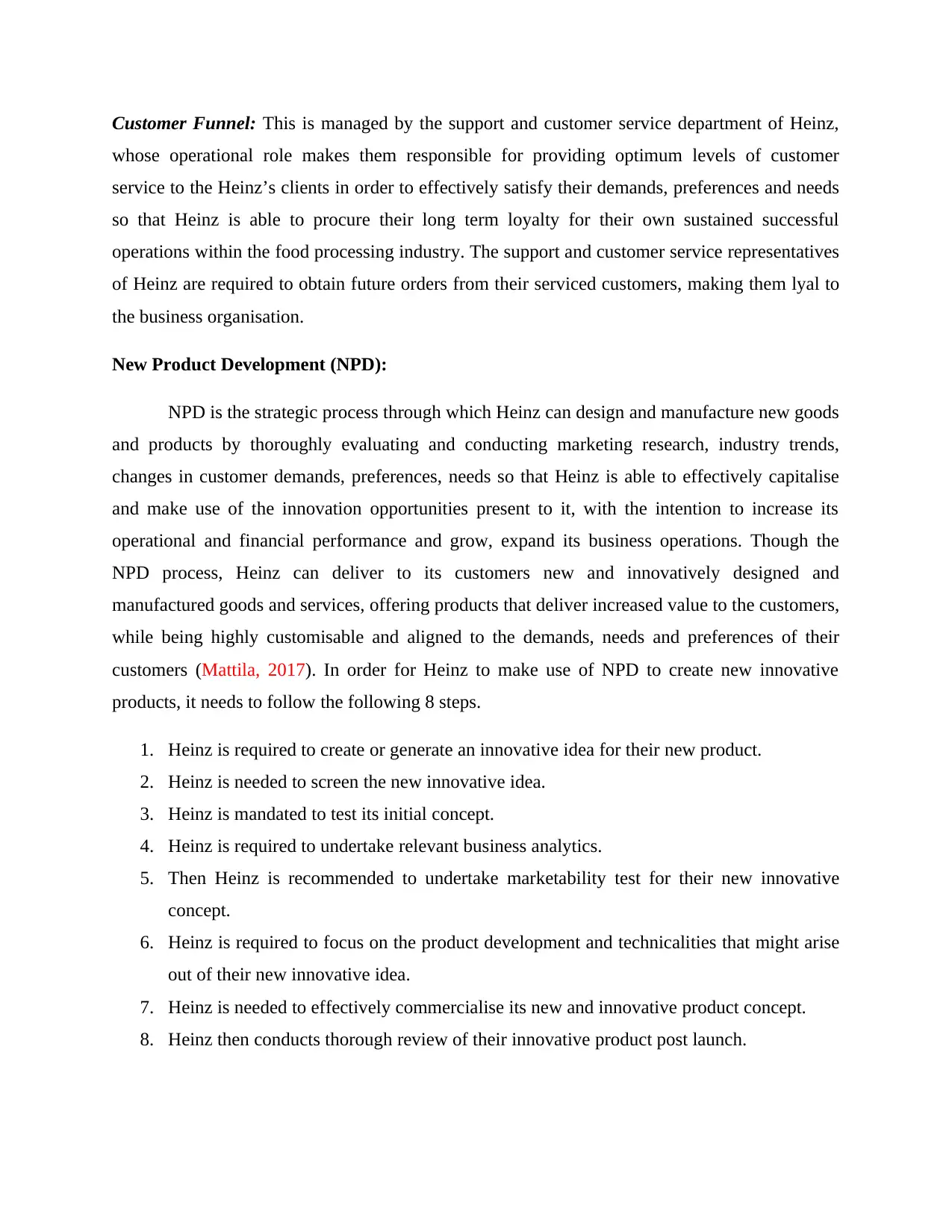
Customer Funnel: This is managed by the support and customer service department of Heinz,
whose operational role makes them responsible for providing optimum levels of customer
service to the Heinz’s clients in order to effectively satisfy their demands, preferences and needs
so that Heinz is able to procure their long term loyalty for their own sustained successful
operations within the food processing industry. The support and customer service representatives
of Heinz are required to obtain future orders from their serviced customers, making them lyal to
the business organisation.
New Product Development (NPD):
NPD is the strategic process through which Heinz can design and manufacture new goods
and products by thoroughly evaluating and conducting marketing research, industry trends,
changes in customer demands, preferences, needs so that Heinz is able to effectively capitalise
and make use of the innovation opportunities present to it, with the intention to increase its
operational and financial performance and grow, expand its business operations. Though the
NPD process, Heinz can deliver to its customers new and innovatively designed and
manufactured goods and services, offering products that deliver increased value to the customers,
while being highly customisable and aligned to the demands, needs and preferences of their
customers (Mattila, 2017). In order for Heinz to make use of NPD to create new innovative
products, it needs to follow the following 8 steps.
1. Heinz is required to create or generate an innovative idea for their new product.
2. Heinz is needed to screen the new innovative idea.
3. Heinz is mandated to test its initial concept.
4. Heinz is required to undertake relevant business analytics.
5. Then Heinz is recommended to undertake marketability test for their new innovative
concept.
6. Heinz is required to focus on the product development and technicalities that might arise
out of their new innovative idea.
7. Heinz is needed to effectively commercialise its new and innovative product concept.
8. Heinz then conducts thorough review of their innovative product post launch.
whose operational role makes them responsible for providing optimum levels of customer
service to the Heinz’s clients in order to effectively satisfy their demands, preferences and needs
so that Heinz is able to procure their long term loyalty for their own sustained successful
operations within the food processing industry. The support and customer service representatives
of Heinz are required to obtain future orders from their serviced customers, making them lyal to
the business organisation.
New Product Development (NPD):
NPD is the strategic process through which Heinz can design and manufacture new goods
and products by thoroughly evaluating and conducting marketing research, industry trends,
changes in customer demands, preferences, needs so that Heinz is able to effectively capitalise
and make use of the innovation opportunities present to it, with the intention to increase its
operational and financial performance and grow, expand its business operations. Though the
NPD process, Heinz can deliver to its customers new and innovatively designed and
manufactured goods and services, offering products that deliver increased value to the customers,
while being highly customisable and aligned to the demands, needs and preferences of their
customers (Mattila, 2017). In order for Heinz to make use of NPD to create new innovative
products, it needs to follow the following 8 steps.
1. Heinz is required to create or generate an innovative idea for their new product.
2. Heinz is needed to screen the new innovative idea.
3. Heinz is mandated to test its initial concept.
4. Heinz is required to undertake relevant business analytics.
5. Then Heinz is recommended to undertake marketability test for their new innovative
concept.
6. Heinz is required to focus on the product development and technicalities that might arise
out of their new innovative idea.
7. Heinz is needed to effectively commercialise its new and innovative product concept.
8. Heinz then conducts thorough review of their innovative product post launch.
Paraphrase This Document
Need a fresh take? Get an instant paraphrase of this document with our AI Paraphraser
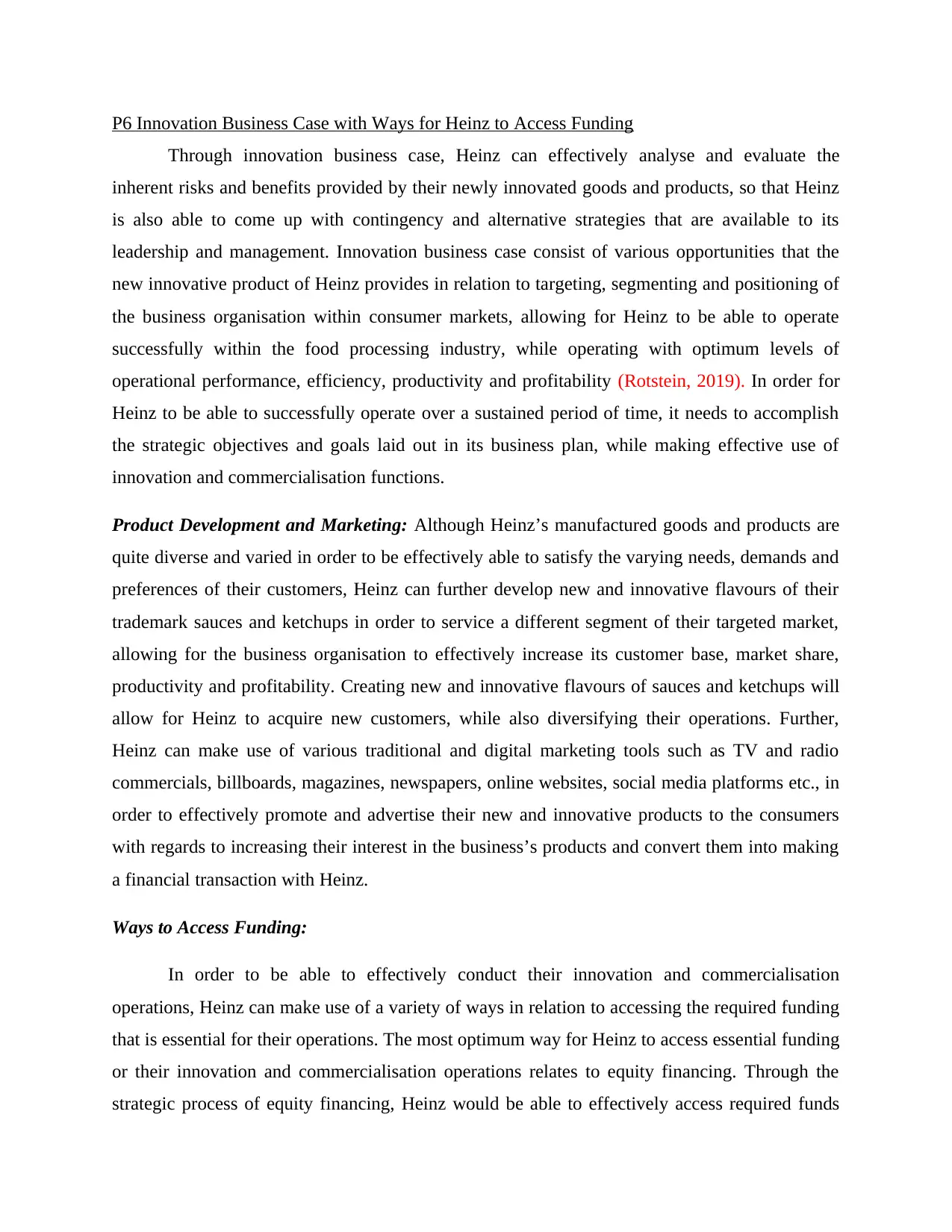
P6 Innovation Business Case with Ways for Heinz to Access Funding
Through innovation business case, Heinz can effectively analyse and evaluate the
inherent risks and benefits provided by their newly innovated goods and products, so that Heinz
is also able to come up with contingency and alternative strategies that are available to its
leadership and management. Innovation business case consist of various opportunities that the
new innovative product of Heinz provides in relation to targeting, segmenting and positioning of
the business organisation within consumer markets, allowing for Heinz to be able to operate
successfully within the food processing industry, while operating with optimum levels of
operational performance, efficiency, productivity and profitability (Rotstein, 2019). In order for
Heinz to be able to successfully operate over a sustained period of time, it needs to accomplish
the strategic objectives and goals laid out in its business plan, while making effective use of
innovation and commercialisation functions.
Product Development and Marketing: Although Heinz’s manufactured goods and products are
quite diverse and varied in order to be effectively able to satisfy the varying needs, demands and
preferences of their customers, Heinz can further develop new and innovative flavours of their
trademark sauces and ketchups in order to service a different segment of their targeted market,
allowing for the business organisation to effectively increase its customer base, market share,
productivity and profitability. Creating new and innovative flavours of sauces and ketchups will
allow for Heinz to acquire new customers, while also diversifying their operations. Further,
Heinz can make use of various traditional and digital marketing tools such as TV and radio
commercials, billboards, magazines, newspapers, online websites, social media platforms etc., in
order to effectively promote and advertise their new and innovative products to the consumers
with regards to increasing their interest in the business’s products and convert them into making
a financial transaction with Heinz.
Ways to Access Funding:
In order to be able to effectively conduct their innovation and commercialisation
operations, Heinz can make use of a variety of ways in relation to accessing the required funding
that is essential for their operations. The most optimum way for Heinz to access essential funding
or their innovation and commercialisation operations relates to equity financing. Through the
strategic process of equity financing, Heinz would be able to effectively access required funds
Through innovation business case, Heinz can effectively analyse and evaluate the
inherent risks and benefits provided by their newly innovated goods and products, so that Heinz
is also able to come up with contingency and alternative strategies that are available to its
leadership and management. Innovation business case consist of various opportunities that the
new innovative product of Heinz provides in relation to targeting, segmenting and positioning of
the business organisation within consumer markets, allowing for Heinz to be able to operate
successfully within the food processing industry, while operating with optimum levels of
operational performance, efficiency, productivity and profitability (Rotstein, 2019). In order for
Heinz to be able to successfully operate over a sustained period of time, it needs to accomplish
the strategic objectives and goals laid out in its business plan, while making effective use of
innovation and commercialisation functions.
Product Development and Marketing: Although Heinz’s manufactured goods and products are
quite diverse and varied in order to be effectively able to satisfy the varying needs, demands and
preferences of their customers, Heinz can further develop new and innovative flavours of their
trademark sauces and ketchups in order to service a different segment of their targeted market,
allowing for the business organisation to effectively increase its customer base, market share,
productivity and profitability. Creating new and innovative flavours of sauces and ketchups will
allow for Heinz to acquire new customers, while also diversifying their operations. Further,
Heinz can make use of various traditional and digital marketing tools such as TV and radio
commercials, billboards, magazines, newspapers, online websites, social media platforms etc., in
order to effectively promote and advertise their new and innovative products to the consumers
with regards to increasing their interest in the business’s products and convert them into making
a financial transaction with Heinz.
Ways to Access Funding:
In order to be able to effectively conduct their innovation and commercialisation
operations, Heinz can make use of a variety of ways in relation to accessing the required funding
that is essential for their operations. The most optimum way for Heinz to access essential funding
or their innovation and commercialisation operations relates to equity financing. Through the
strategic process of equity financing, Heinz would be able to effectively access required funds
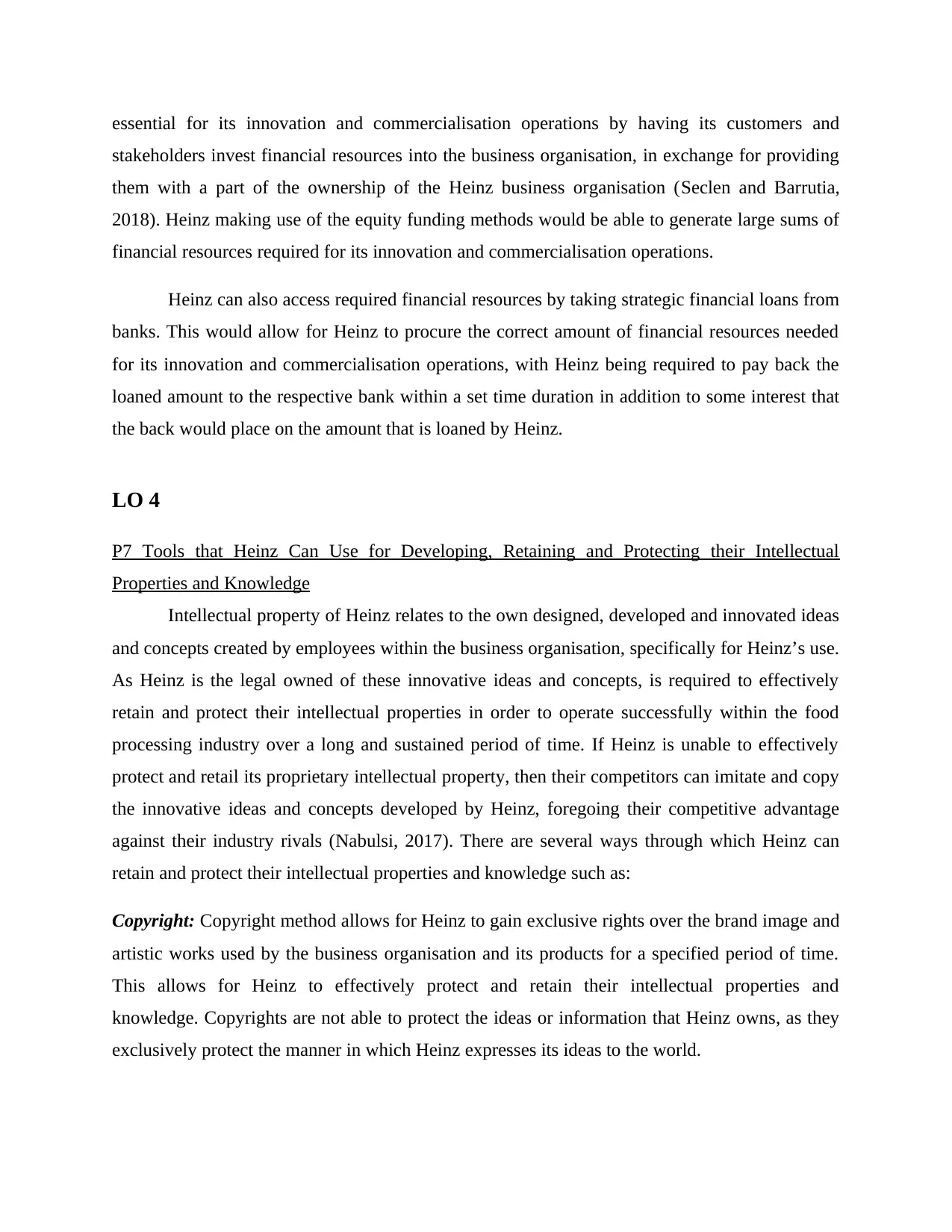
essential for its innovation and commercialisation operations by having its customers and
stakeholders invest financial resources into the business organisation, in exchange for providing
them with a part of the ownership of the Heinz business organisation (Seclen and Barrutia,
2018). Heinz making use of the equity funding methods would be able to generate large sums of
financial resources required for its innovation and commercialisation operations.
Heinz can also access required financial resources by taking strategic financial loans from
banks. This would allow for Heinz to procure the correct amount of financial resources needed
for its innovation and commercialisation operations, with Heinz being required to pay back the
loaned amount to the respective bank within a set time duration in addition to some interest that
the back would place on the amount that is loaned by Heinz.
LO 4
P7 Tools that Heinz Can Use for Developing, Retaining and Protecting their Intellectual
Properties and Knowledge
Intellectual property of Heinz relates to the own designed, developed and innovated ideas
and concepts created by employees within the business organisation, specifically for Heinz’s use.
As Heinz is the legal owned of these innovative ideas and concepts, is required to effectively
retain and protect their intellectual properties in order to operate successfully within the food
processing industry over a long and sustained period of time. If Heinz is unable to effectively
protect and retail its proprietary intellectual property, then their competitors can imitate and copy
the innovative ideas and concepts developed by Heinz, foregoing their competitive advantage
against their industry rivals (Nabulsi, 2017). There are several ways through which Heinz can
retain and protect their intellectual properties and knowledge such as:
Copyright: Copyright method allows for Heinz to gain exclusive rights over the brand image and
artistic works used by the business organisation and its products for a specified period of time.
This allows for Heinz to effectively protect and retain their intellectual properties and
knowledge. Copyrights are not able to protect the ideas or information that Heinz owns, as they
exclusively protect the manner in which Heinz expresses its ideas to the world.
stakeholders invest financial resources into the business organisation, in exchange for providing
them with a part of the ownership of the Heinz business organisation (Seclen and Barrutia,
2018). Heinz making use of the equity funding methods would be able to generate large sums of
financial resources required for its innovation and commercialisation operations.
Heinz can also access required financial resources by taking strategic financial loans from
banks. This would allow for Heinz to procure the correct amount of financial resources needed
for its innovation and commercialisation operations, with Heinz being required to pay back the
loaned amount to the respective bank within a set time duration in addition to some interest that
the back would place on the amount that is loaned by Heinz.
LO 4
P7 Tools that Heinz Can Use for Developing, Retaining and Protecting their Intellectual
Properties and Knowledge
Intellectual property of Heinz relates to the own designed, developed and innovated ideas
and concepts created by employees within the business organisation, specifically for Heinz’s use.
As Heinz is the legal owned of these innovative ideas and concepts, is required to effectively
retain and protect their intellectual properties in order to operate successfully within the food
processing industry over a long and sustained period of time. If Heinz is unable to effectively
protect and retail its proprietary intellectual property, then their competitors can imitate and copy
the innovative ideas and concepts developed by Heinz, foregoing their competitive advantage
against their industry rivals (Nabulsi, 2017). There are several ways through which Heinz can
retain and protect their intellectual properties and knowledge such as:
Copyright: Copyright method allows for Heinz to gain exclusive rights over the brand image and
artistic works used by the business organisation and its products for a specified period of time.
This allows for Heinz to effectively protect and retain their intellectual properties and
knowledge. Copyrights are not able to protect the ideas or information that Heinz owns, as they
exclusively protect the manner in which Heinz expresses its ideas to the world.
⊘ This is a preview!⊘
Do you want full access?
Subscribe today to unlock all pages.

Trusted by 1+ million students worldwide
1 out of 14
Related Documents
Your All-in-One AI-Powered Toolkit for Academic Success.
+13062052269
info@desklib.com
Available 24*7 on WhatsApp / Email
![[object Object]](/_next/static/media/star-bottom.7253800d.svg)
Unlock your academic potential
Copyright © 2020–2025 A2Z Services. All Rights Reserved. Developed and managed by ZUCOL.





